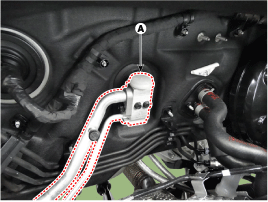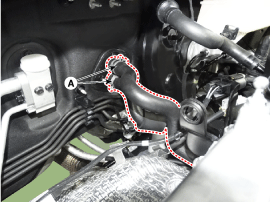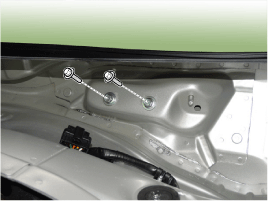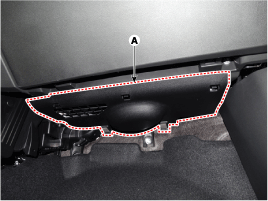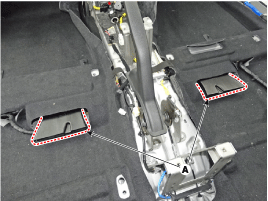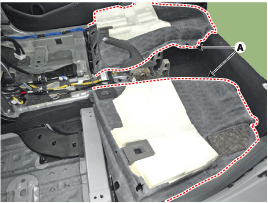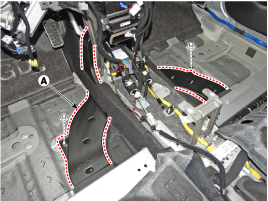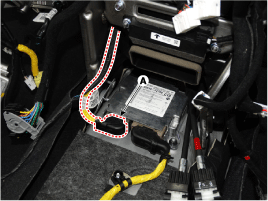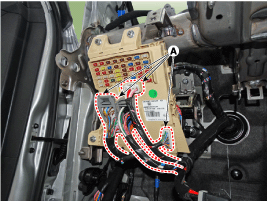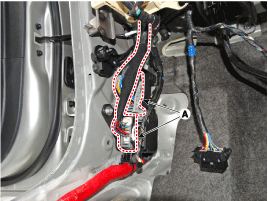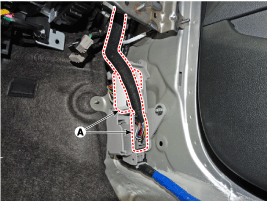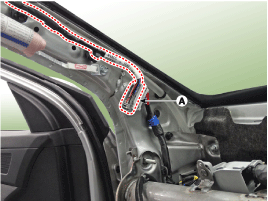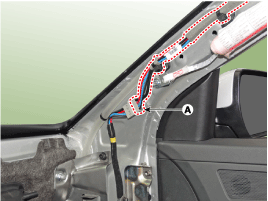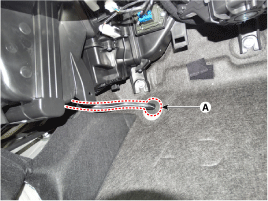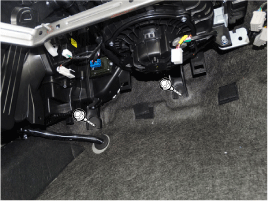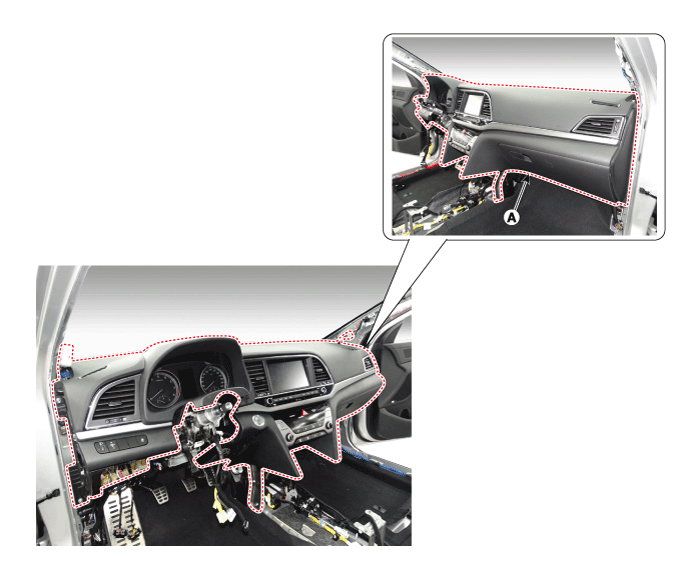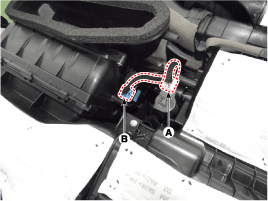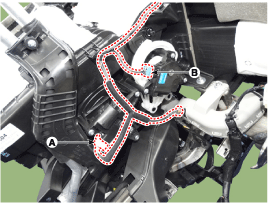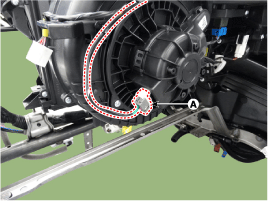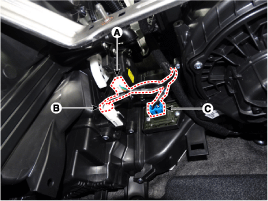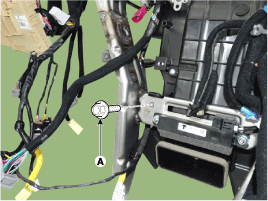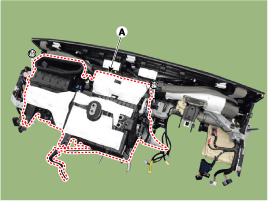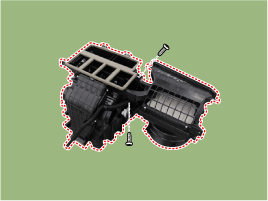Hyundai Elantra: Blower / Blower Unit Repair procedures
Hyundai Elantra AD (2016-2020) Service Manual / Heating, Ventilation and Air Conditioning / Blower / Blower Unit Repair procedures
| Replacement |
When prying with a flat-tip screwdriver or use a prying trim
tool, wrap it with protective tape, and apply protective tape around the
related parts, to prevent damage. |
| 1. |
Disconnect the negative (-) battery terminal. |
| 2. |
Recover the refrigerant with a recovery / recycling / charging station. |
| 3. |
When the engine is cool, drain the engine coolant from the radiator.
(Refer to Engine Mechanical System - "Coolant") |
| 4. |
Remove the cowl top cover.
(Refer to Body - "Cowl Top Cover") |
| 5. |
Remove the bolts and the expansion valve (A) from the evaporator core.
|
| 6. |
Disconnect the heater hoses (A) from the heater unit.
|
| 7. |
Loosen the cowl cross member mounting bolts.
|
| 8. |
Remove the floor console assembly.
(Refer to Body - "Floor Console Assembly") |
| 9. |
Remove the crash pad lower panel.
(Refer to Body - "Crash Pad Lower Panel") |
| 10. |
Remove both sides of the front pillar trim.
(Refer to Body - "Front Pillar Trim") |
| 11. |
Remove the cowl side trim.
(Refer to Body - "Cowl Side Trim") |
| 12. |
Remove the steering column shroud lower panel.
(Refer to Body - "Steering Column Shroud Panel") |
| 13. |
Remove the steering wheel.
(Refer to Steering System - "Steering Wheel") |
| 14. |
Remove the multifunction switch.
(Refer to Body Electrical System - "Multifunction Switch") |
| 15. |
Lower the steering column after loosening the mounting bolts.
(Refer to Steering System - "Steering Column and Shaft") |
| 16. |
Remove the shift lever assembly.
(Refer to Automatic Transmission System - "Shift Lever") |
| 17. |
Remove the crash pad under cover [RH](A).
|
| 18. |
Remove the rear air duct (A).
|
| 19. |
Separate the floor carpet (A) to obtain space for removing the rear heating duct.
|
| 20. |
Loosen the mounting nut and remove the front air duct (A).
|
| 21. |
Disconnect the airbag control module (SRSCM) connector (A).
|
| 22. |
Disconnect the junction box connectors (A).
|
| 23. |
Disconnect the multi box connectors (A).
[Driver's side]
[Passenger's side]
|
| 24. |
Disconnect the connectors (A) and the mounting clips in the front pillar.
[Driver's side]
[Passenger's side]
|
| 25. |
Remove the drain hose (A).
|
| 26. |
Loosen the cowl blower unit mounting bolts.
|
| 27. |
After loosening the bolts and nuts remove the main crash pad and cowl cross bar assembly (A) together.
|
| 28. |
Disconnect the heater & blower unit connectors.
|
| 29. |
Loosen the heater & blower unit mounting bolt (A).
|
| 30. |
Remove the heater and blower unit (A) from the crash pad after loosening the mounting nuts.
|
| 31. |
Separate the blower unit (A) from the heater unit (B) after loosening the screws.
|
| 32. |
To intall, reverse the removal procedure. |
 Blower Unit Components and Components Location
Blower Unit Components and Components Location
Component Location
1. Blower unit assembly
Components
1. Seal2. Intake duct case3. Intake actuator4. Intake door5. Intake duct case [A]6. Air filter cover7. Air filter8. Blower unit pad9. ...
 Blower Motor Repair procedures
Blower Motor Repair procedures
Inspection
1.
Connect the battery voltage and check the blower motor rotation.
2.
If the blower motor does not operate well, substitute with a known-good blower motor and check for proper oper ...
Other information:
Hyundai Elantra AD (2016-2020) Service Manual: Front Axle Assembly
Front Hub / Knuckle Components and Components Location
Components
1. Brake disc2. Hub bearing3. Dust cover4. Knuckle
Front Hub / Knuckle Repair procedures
Removal
1.
Loosen the wheel nuts slightly.
Raise the vehicle, and make sure it is securely supported.
2.
Remove the front wheel ...
Hyundai Elantra AD (2016-2020) Service Manual: Description and Operation
Description
Adaptive Front-lighting System (AFLS)
AFLS(Adaptive Front-lighting System)is a headlamp orientation
control system that takes into account both steering angle and vehicle
speed to orient the headlamps to an angle that provides better nighttime
visibility.
Variable conditions ...
© 2018-2026 www.helantraad.com


